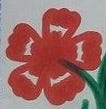India: A dream come true
An Essay by Anonymous
When I was a child, I watched Indian serials which were televised. India for me was Bollywood and its movies. I thought all families lived in homes with their grandparents, uncles and aunts. They would all be speaking Hindi and know some English. I envisioned the people of India as tall and dark, with big eyes and curly hair. Women would be wearing saris that revealed their stomachs and girls wore panjabis. Men in offices wore suits but at home they wore a top that was long to their knees and instead of pants that had some sort of cloth tied at the waist that covered their legs. From the movies I knew that the people worshipped different Hindu statues, went to the temple to light candles and put coconuts out for their gods. In their weddings, brides wore beautiful red saris with lots of gold and men wore the long tops and pants they wore at home only fancier. During the marriage ceremony they circled a fire.
It was all I learned about India from the serials and it all seemed exotic and interesting and I dreamed of going there to see everything for myself. But when I grew older the Indian serials were not televised anymore and I forget about India, for a while, and all those beautiful girls with the saris who were dancing in my dreams.
Time passed and I got the opportunity to visit India when I was 22. All my dreams came back to me. I was excited that I was going to see everything I’d seen on TV.
When I got off the airplane, the first thing I noticed was the insufferable weather of Delhi. It was more than 40 Celsius (104 Fahrenheit). I had never lived in such a heat. Bearing it was difficult for me. I stayed in Delhi for a few days. It was definitely a new experience.
During my stay I realized India was very different from what I had seen in the serials. But it was still more exotic than any place I’d ever been. Delhi is a crowded hot city with many homeless people in the street. Every 20 meters or so you will find a small park with many people walking around, reading books and children playing nearby. I saw many tourists from different countries who came to experience India and learn about its history and current conditions.
After Delhi, I went to the northeast of India where I stayed longer in the state of Meghalaya and the city of Shillong. When I got to Shillong, it was completely different. I was pleasantly surprised to find that it was hilly and green and cold in the middle of summer. I needed to use a sweater. People here were Christians and you could see many beautiful churches there. Brides wore a white gown and grooms wore black suits in their weddings. Mostly, they were not living in joint family homes. People fell in love and married. Women and men were dressed like western people. Few women wore saris and few girls wore panjabis. Some women were dressed in jainsam or dhara, traditional Khasi clothing. Both of these are elaborate with several pieces of cloth, giving the body a cylindrical shape. The language in this part of the country is Khasi.
India was so very different from what I saw on TV. Each state of India had their own rules, language and culture. It is one of the most diverse countries in the world with people from all different backgrounds, religions, ethnicities and customs living side-by-side. I saw many beautiful cultural and historic places in India and each was different. There were old temples, old mosques and old churches. Descriptions were written in many different languages including Persian and Hindi. But the real beauty of India is its warm and welcoming multi-cultural people. Everyone should have a chance to experience this richly diverse place for themselves.
